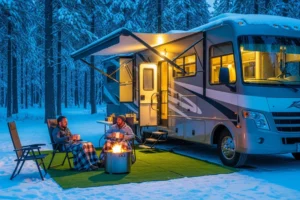The Ultimate Guide to Adirondack Camping: Best RV & Tent Sites
Imagine waking up to the sound of loons calling across a pristine lake, surrounded by six million acres of protected wilderness that offers some of the most spectacular camping experiences on the East Coast. The Adirondack Park in upstate New York isn’t just a destination—it’s a gateway to adventure that combines rugged wilderness with family-friendly amenities.
Whether you’re planning your first camping trip or you’re a seasoned outdoor enthusiast, the Adirondacks offer something magical for every type of camper. From luxury RV resorts with full hookups to primitive backcountry sites where the only sounds are those of nature, this vast wilderness area provides endless opportunities for unforgettable outdoor experiences.
Key Takeaways
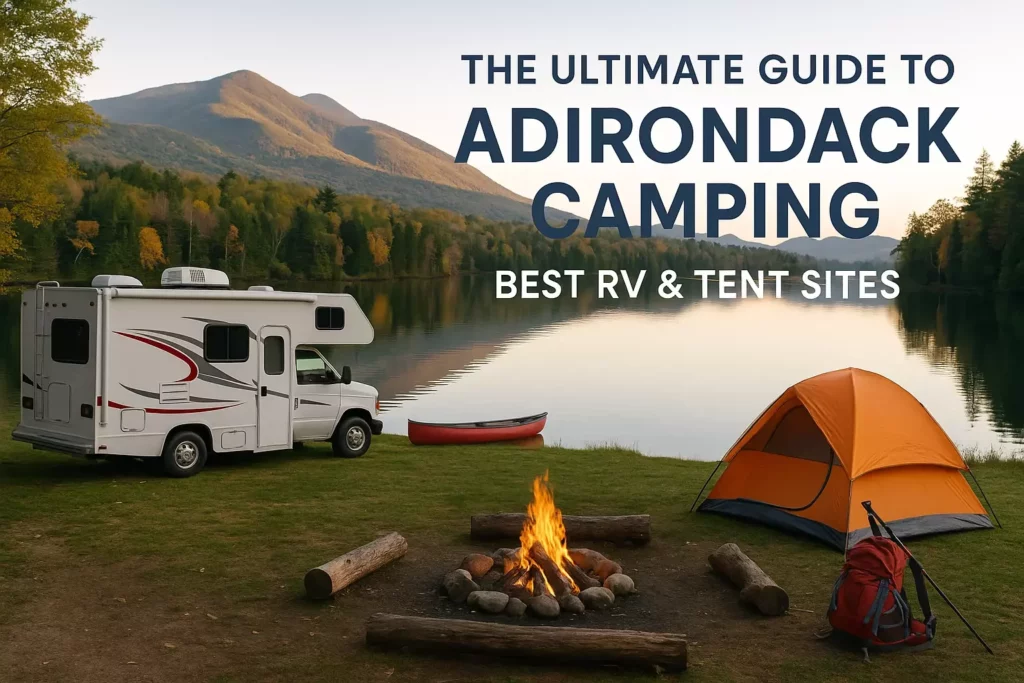
- Choose your camping style: The Adirondacks offer everything from primitive tent sites to luxury RV resorts with full amenities
- Plan ahead: Popular campgrounds fill up quickly, especially during peak summer months and fall foliage season
- Understand the regulations: Different areas have varying rules for camping, fires, and wildlife protection
- Pack appropriately: Weather can change rapidly in the mountains, requiring proper gear and clothing
- Respect the wilderness: Follow Leave No Trace principles to preserve this incredible ecosystem for future generations
Understanding the Adirondack Park
The Adirondack Park spans over six million acres across northern New York, making it larger than Yellowstone, Everglades, Glacier, and Grand Canyon National Parks combined. This unique “forever wild” preserve contains a patchwork of public and private lands, creating diverse camping opportunities throughout the region.
Climate and Best Times to Visit
The Adirondack climate varies significantly by season:
🌞 Summer (June-August)
- Temperatures: 60-80°F during the day, 40-60°F at night
- Peak camping season with the warmest weather
- Highest demand for campsites
🍂 Fall (September-November)
- Temperatures: 40-70°F during the day, 20-50°F at night
- Spectacular fall foliage (peak in late September/early October)
- Cooler nights require proper sleeping gear
❄️ Winter (December-March)
- Temperatures: 10-30°F during the day, -10-20°F at night
- Limited camping options, mostly for experienced winter campers
🌸 Spring (April-May)
- Temperatures: 40-65°F during the day, 25-45°F at night
- Mud season with wet conditions but fewer crowds
Top RV Camping Destinations
1. Lake George RV Park
Location: Lake George Village
Hookups: Full 30/50 amp service
Amenities: Pool, beach access, Wi-Fi, camp store
This premier RV destination offers direct access to Lake George with stunning mountain views. The park accommodates RVs up to 45 feet and provides easy access to the village’s restaurants and attractions.
Best For: Families wanting amenities and lake activities
Reservations: Book 6+ months ahead for summer dates
2. Ausable Point Campground
Location: Peru, NY (near Lake Champlain)
Sites: 123 RV sites with full hookups
Special Features: Beach access, boat launch, playground
Located on the shores of Lake Champlain, this state campground offers excellent fishing and boating opportunities. The sites are spacious and well-maintained, with modern restroom facilities.
Best For: RV campers who enjoy water activities
Season: May through October
3. Cranberry Lake Campground
Location: Cranberry Lake
Sites: 173 campsites (many suitable for RVs)
Highlights: Remote location, excellent fishing, canoe access
This more secluded option provides a true wilderness experience while still accommodating larger RVs. The campground offers access to the Cranberry Lake Wild Forest.
Best For: RV campers seeking a wilderness experience
Note: Limited cell service enhances the disconnect from daily life
Premier Tent Camping Sites
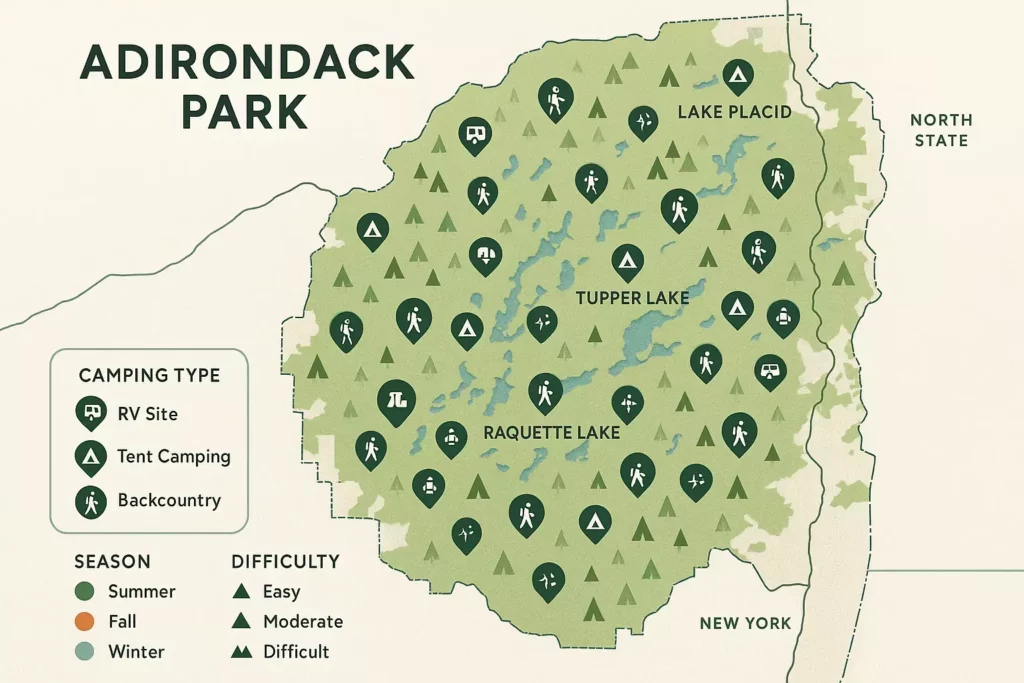
1. Rollins Pond Campground
Location: Fish Creek Pond area
Sites: 287 tent and trailer sites
Features: Sandy beach, canoe rentals, hiking trails
This family-friendly campground offers a perfect introduction to Adirondack camping. The sites are well-spaced, and the area provides easy access to multiple ponds and hiking opportunities.
Ideal For: First-time tent campers and families
Activities: Swimming, canoeing, wildlife viewing
2. Eighth Lake Campground
Location: Inlet, NY
Sites: 126 campsites
Special Features: Mountain lake setting, boat launch, hiking access
Nestled in the central Adirondacks, this campground provides access to the Fulton Chain of Lakes and numerous hiking trails, including routes to nearby peaks.
Best For: Tent campers who enjoy hiking and paddling
Highlight: Stunning sunset views over the lake
3. Lake Harris Campground
Location: Newcomb
Sites: 89 tent sites
Features: Remote location, pristine lake, excellent fishing
This quieter campground offers a more primitive camping experience with basic amenities. The location provides excellent access to the High Peaks region.
Perfect For: Experienced campers seeking solitude
Activities: Fishing, hiking, stargazing
Backcountry and Primitive Camping
For those seeking the ultimate wilderness experience, the Adirondacks offer extensive backcountry camping opportunities.
Regulations and Permits
- No permits required for most backcountry camping
- 150-foot rule: Camp at least 150 feet from water sources and trails
- Group size limit: Maximum 8 people per group
- Fire restrictions: Check current fire danger levels
Popular Backcountry Areas
High Peaks Wilderness
- Most challenging and rewarding hiking
- Designated camping areas near popular peaks
- Requires excellent backpacking preparation
St. Regis Canoe Area
- Motor-free paddling paradise
- Island camping opportunities
- Perfect for canoe camping adventures
Pharaoh Lake Wilderness
- Excellent hiking and fishing
- Less crowded than High Peaks
- Multiple lake camping options
Essential Camping Gear for the Adirondacks
Weather Protection
The Adirondack weather can change rapidly, making proper gear essential:
- Layered clothing system including cool weather camping clothes
- Waterproof rain gear for sudden storms
- Warm sleeping bag rated for nighttime temperatures
- Quality tent with good ventilation and weather resistance
Safety Equipment
- Comprehensive first aid kit for remote locations
- Water purification system for backcountry camping
- Bear-proof food storage containers or rope for hanging food
- Emergency communication device for backcountry areas
Comfort Items
- Comfortable camp chairs for relaxing by the fire
- Portable camp table for meal preparation
- Quality cooler for extended stays
- Bushcraft and survival tools for emergency situations
Family-Friendly Camping Tips
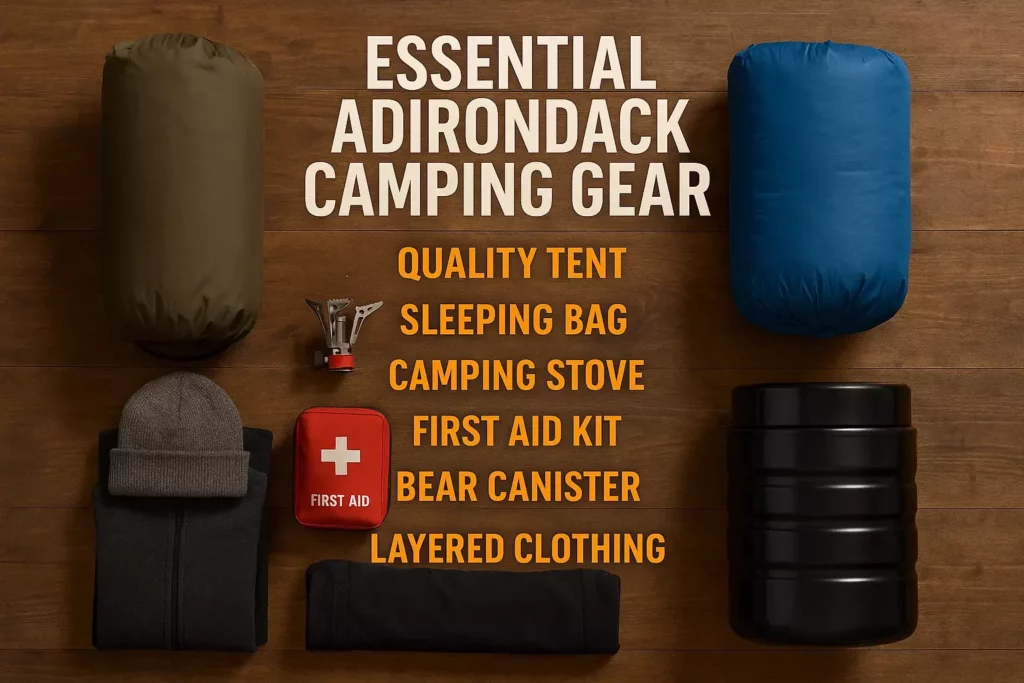
Choosing the Right Campground
When camping with kids, consider these factors:
- Restroom proximity to your campsite
- Swimming opportunities for hot days
- Playground facilities at the campground
- Easy hiking trails suitable for small legs
- Camp store availability for forgotten essentials
Keeping Kids Engaged
The Adirondacks offer numerous family camping activities:
- Nature scavenger hunts using local flora and fauna
- Junior Ranger programs at state campgrounds
- Easy hiking trails with waterfalls or scenic viewpoints
- Lake activities like swimming and canoeing
- Campfire programs with stories and s’mores
Cooking and Dining in the Adirondacks
Campfire Cooking Essentials
Master the art of campfire cooking with these Adirondack favorites:
Breakfast Ideas
- Cast iron pancakes with local maple syrup
- Campfire coffee with mountain views
- Bacon and eggs cooked over open flames
Dinner Options
- Fresh-caught fish from Adirondack lakes
- Dutch oven stews and chili
- Grilled vegetables and meats
Food Storage and Safety
Bear Safety Protocols
- Store all food in bear-proof containers
- Never leave food unattended
- Clean cooking areas thoroughly after meals
- Hang food at least 12 feet high and 6 feet from tree trunks
Seasonal Considerations
Summer Camping (June-August)
Advantages:
- Warmest weather and longest days
- All facilities and trails open
- Best swimming and water activities
- Peak wildlife viewing opportunities
Challenges:
- Highest crowds and prices
- Insects can be problematic
- Thunderstorms possible
- Reservations essential
Fall Camping (September-November)
Advantages:
- Spectacular fall foliage
- Cooler temperatures and fewer bugs
- Lower campground rates
- Excellent hiking weather
Challenges:
- Rapidly changing weather
- Some facilities may close early
- Shorter daylight hours
- Need for warmer gear
Spring Camping (April-May)
Advantages:
- Fewer crowds and lower rates
- Wildflower blooms
- Excellent fishing
- Moderate temperatures
Challenges:
- Mud season conditions
- Some roads and trails may be closed
- Unpredictable weather
- Limited facility availability
Reservation Strategies and Booking Tips
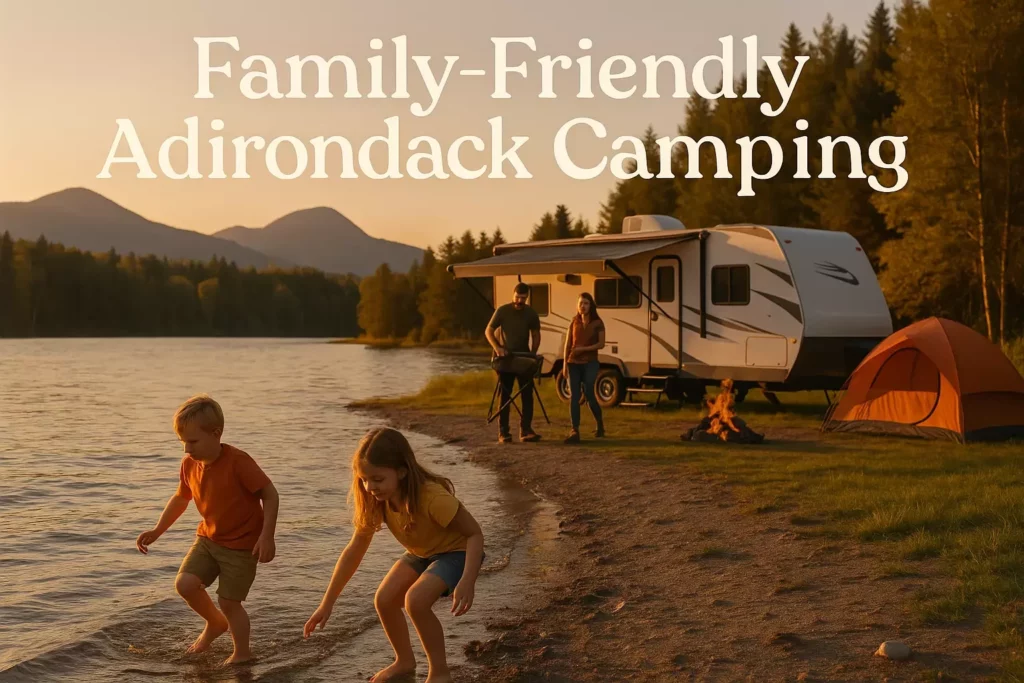
When to Book
- Summer reservations: Book 9+ months in advance
- Fall foliage season: Reserve by January for best sites
- Spring camping: Book 3-6 months ahead
- Last-minute options: Check for cancellations regularly
Booking Platforms
- New York State Parks: ReserveAmerica.com
- Private campgrounds: Individual websites or phone reservations
- Backcountry camping: No reservations needed (first-come, first-served)
Money-Saving Tips
- Off-season rates can be 30-50% lower
- Midweek stays often cost less than weekends
- State park annual passes pay for themselves after 3-4 visits
- Group discounts available at many private campgrounds
Wildlife and Safety Considerations
Common Adirondack Wildlife
Large Mammals
- Black bears: Common throughout the region
- White-tailed deer: Abundant in all areas
- Moose: Occasionally spotted in northern areas
- Coyotes: Present but rarely seen
Small Animals
- Raccoons: Notorious for getting into food
- Chipmunks and squirrels: Common camp visitors
- Porcupines: Can damage gear if attracted to salt
Safety Protocols
Bear Encounters
- Make noise while hiking
- Never approach or feed bears
- If you see a bear, back away slowly
- Fight back if attacked (black bears)
General Wildlife Safety
- Store all scented items properly
- Never feed any wild animals
- Keep campsites clean and food secured
- Report aggressive animal behavior to rangers
🏕️ Find Your Perfect Adirondack Campground
Environmental Responsibility and Leave No Trace
Core Principles for Adirondack Camping
Plan Ahead and Prepare
- Research regulations and special concerns
- Prepare for extreme weather and emergencies
- Schedule your trip to avoid times of high use
Travel and Camp on Durable Surfaces
- Use established campsites and trails
- Camp at least 150 feet from lakes and streams
- Keep campsites small and focus activity in areas where vegetation is absent
Dispose of Waste Properly
- Pack out all trash, leftover food, and litter
- Deposit solid human waste in catholes 6-8 inches deep
- Pack out toilet paper and hygiene products
Leave What You Find
- Preserve the past: examine but don’t touch cultural artifacts
- Leave rocks, plants, and other natural objects as you find them
- Minimize campsite alterations
Emergency Preparedness
Communication in Remote Areas
Many Adirondack camping areas have limited or no cell phone coverage. Consider these communication options:
- Satellite communicators for true emergencies
- Two-way radios for group communication
- Emergency whistles for signaling help
- Written itinerary left with trusted contacts
Weather Emergency Procedures
Severe Thunderstorms
- Seek shelter in hard-sided vehicles or buildings
- Avoid tall trees and open areas
- Wait 30 minutes after last thunder before resuming activities
Flash Flood Risks
- Never camp in dry creek beds or low-lying areas
- Move to higher ground immediately if flooding occurs
- Avoid crossing flooded streams or roads
Planning Your Adirondack Adventure
Creating the Perfect Itinerary
Day 1: Arrival and Setup
- Arrive early to secure the best campsite location
- Set up camp and familiarize yourself with facilities
- Take a short hike to get oriented with the area
Day 2-3: Exploration
- Plan one major activity per day (hiking, paddling, fishing)
- Include rest time and camp maintenance
- Explore nearby attractions and scenic viewpoints
Day 4: Departure
- Break camp early and clean thoroughly
- Take one final hike or activity before leaving
- Stop at local towns for supplies or dining
Budget Planning
Typical Costs (per night)
- State campgrounds: $20-35
- Private RV parks: $40-80
- Backcountry camping: Free
- Group sites: $50-100
Additional Expenses
- Park entrance fees: $8-10 per vehicle
- Firewood: $8-12 per bundle
- Canoe rentals: $30-50 per day
- Fishing licenses: $25-50 (varies by residency)
Conclusion
The Adirondack Park offers unparalleled camping experiences that create lifelong memories and deep connections with nature. Whether you choose a luxury RV resort with all the amenities or venture into the backcountry for a primitive wilderness experience, the key to success lies in proper planning and preparation.
Remember that the best campground is the one that matches your experience level, desired activities, and comfort preferences. Start with established campgrounds if you’re new to the area, and gradually work your way up to more challenging and remote locations as your skills and confidence grow.
Take Action Today:
- Choose your camping style and preferred season for visiting
- Make reservations early for popular campgrounds, especially during peak seasons
- Prepare your gear according to the season and activities you’ve planned
- Research specific regulations for your chosen camping area
- Create a detailed itinerary and share it with family or friends
The Adirondacks are calling—answer with confidence, respect for the wilderness, and excitement for the adventures that await. Every sunrise over an Adirondack lake and every evening spent around a crackling campfire will remind you why this special place continues to captivate outdoor enthusiasts from around the world.


